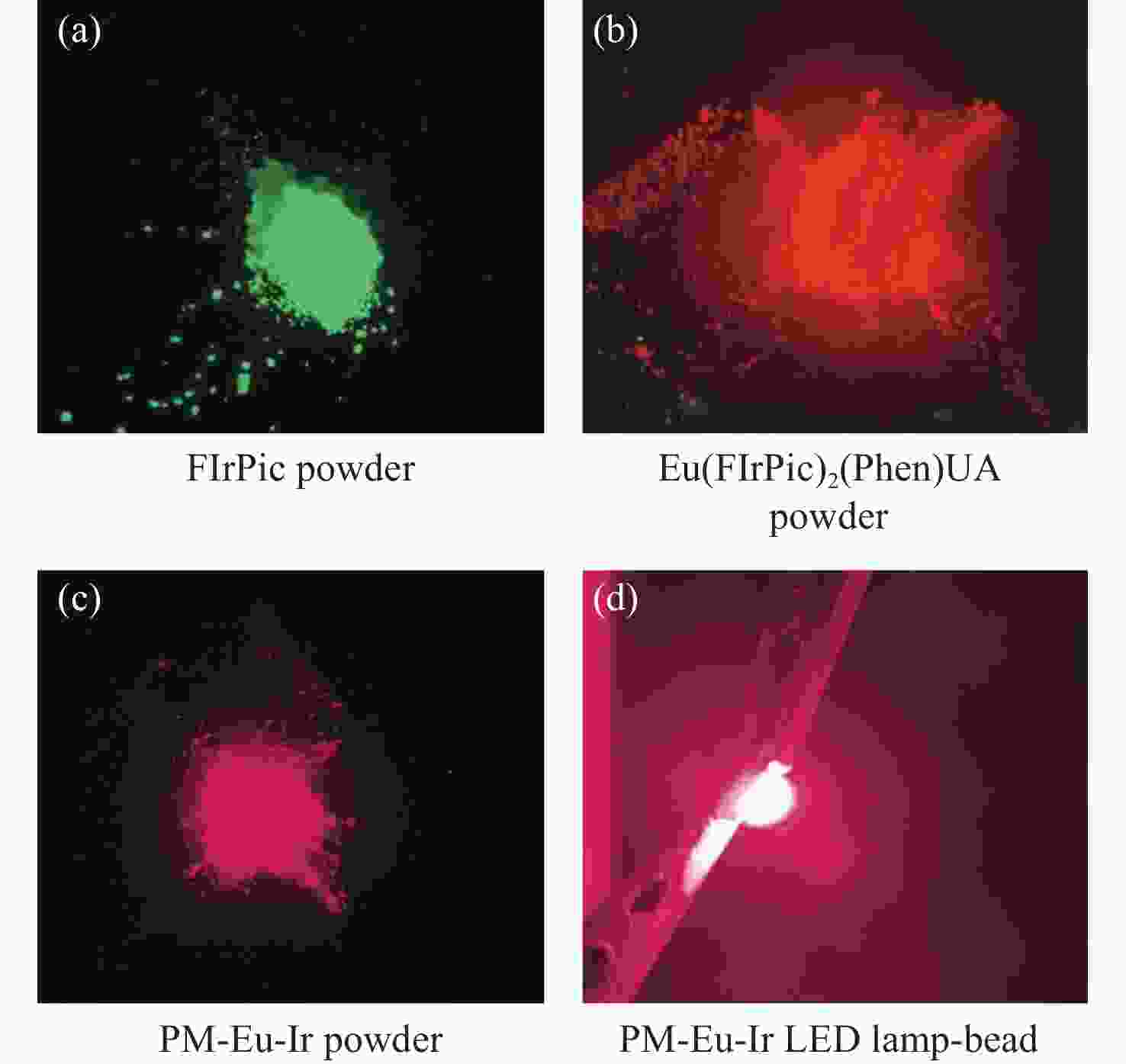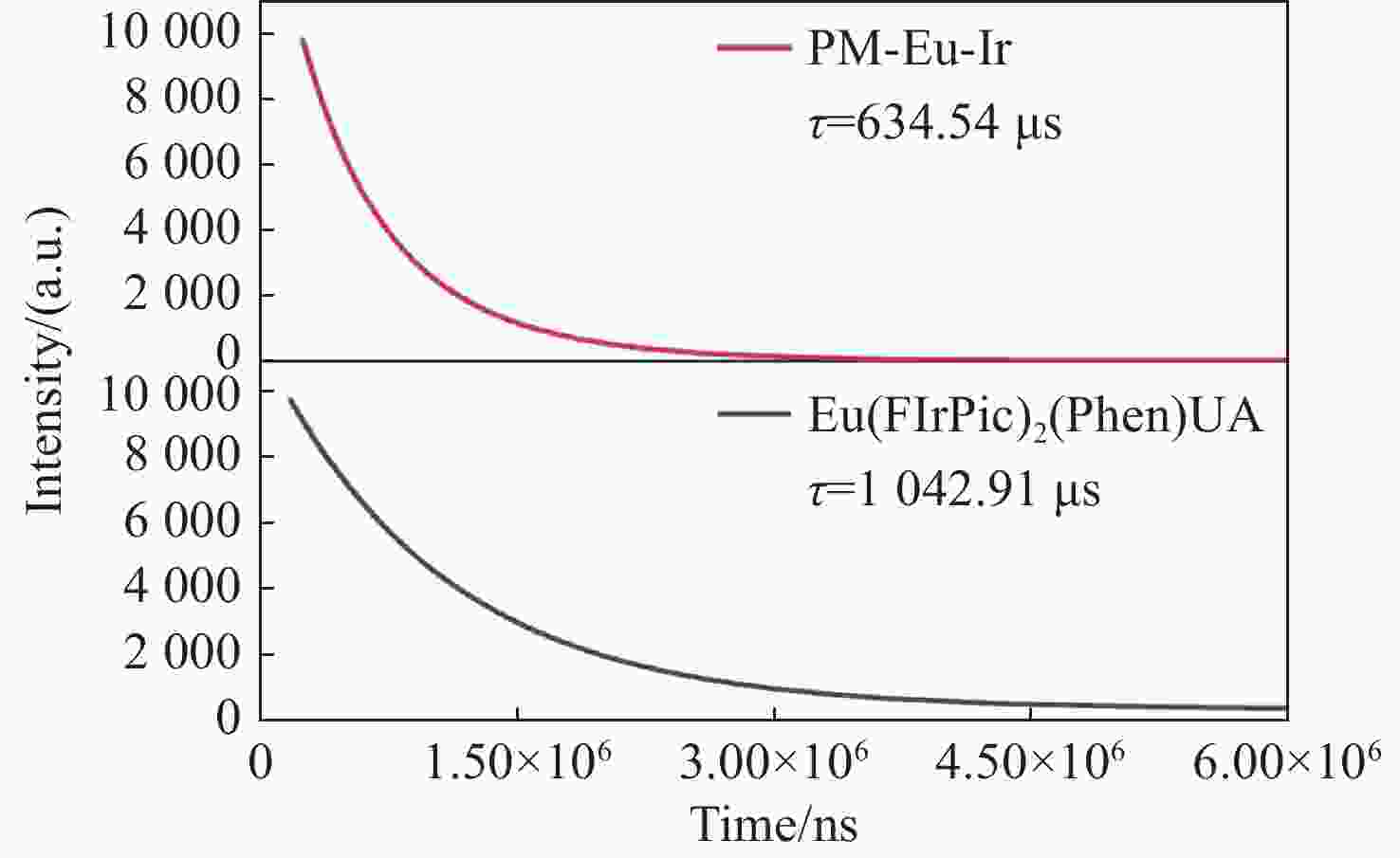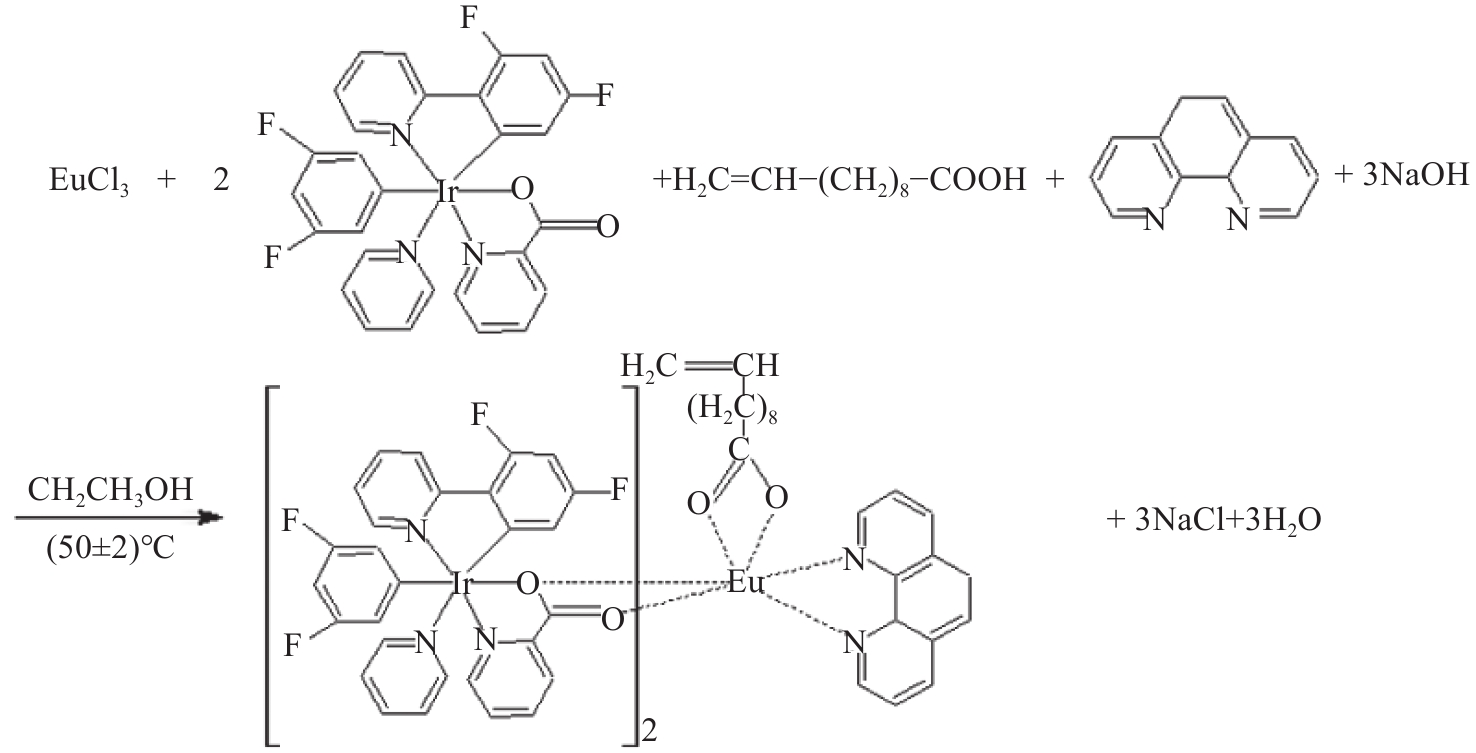A red-emitting copolymer phosphors based on bimetallic Eu-Ir complex for Near-UV chip-based LEDs
doi: 10.37188/CO.EN-2023-0023
-
摘要:
本研究以Ir配合物FIrPic作为Eu离子的配体,合成了一种新的Eu-Ir双金属配合物Eu(FIrPic)2(Phen)UA,并通过自由基聚合成功制备了红色发光荧光共聚物PM-Eu-Ir,适用于商用近紫外芯片型LED。在不影响 Eu3+ 离子的荧光发射特性的前提下,加入 Ir-配合物可以有效地敏化 Eu3+ 离子,增强其对 400 nm紫外光的吸收。在 365 nm 紫外光激发下,共聚物 PM-Eu-Ir 在 612 nm 处显示出最强的发射峰,其 CIE 坐标为(0.461,0.254),这与 365 nm 近紫外芯片非常吻合。红色共聚荧光粉 PM-Eu-Ir 的微观形貌为典型的多层空间网络结构,除了表现出明显的红光发射和 634.54 μs 的荧光寿命外,还在 25~250 °C 的宽温范围内具有优异的热稳定性。使用共聚物 PM-Eu-Ir 制作的 LED 发出的红光亮度为 149800 cd/m2。研究结果表明,所制备的共聚荧光粉可作为红光元件用于制造近紫外芯片白光 LED。
Abstract:In this paper, a new Eu-Ir bimetallic complex Eu(FIrPic)2(Phen)UA is synthesized using the Ir complex FIrPic as ligands for Eu ions and red-emitting phosphorescent copolymer PM-Eu-Ir is successfully prepared via radical polymerization for commercial near UV chip-based LEDs. The Eu3+ ions were found to be effectively sensitizable by adding Ir-complex with enhanced ultra-violet light absorption at around 400 nm without affecting the fluorescence emission characteristic of the Eu3+ ions. The proposed copolymer PM-Eu-Ir exhibits the strongest emission peak at 612 nm with the CIE coordinates (0.461, 0.254) under 365 nm ultra-violet light excitation, which matches well with the 365 nm near-UV chip. The micro-morphology of the red copolymer phosphor PM-Eu-Ir is a typical multilayer spatial network structure; as well as having appreciable red emission and the corresponding fluorescence lifetime of 634.54 μs, it also has excellent thermal stability in a wide range of 25~250 °C. The LEDs fabricated by the copolymer PM-Eu-Ir display red light emission with a 149800 cd/m2 luminance. The results support the potential utilization of prepared copolymer phosphor as a red component in the fabrication of near UV chip-based white LEDs.
-
Key words:
- rare-earth luminescent ions /
- bimetallic complexes /
- copolymer phosphors /
- NUV LED chips
-
Table 1. FT-IR characteristic peaks of the ligands, complex Eu(FIrPic)2(Phen)UA
Complex vC=O(-COOH) $\nu_{{\mathrm{as}}({\mathrm{CH}}_2)} $ $\nu_{{\mathrm{s}}({\mathrm{CH}}_2)} $ νC-OH δC-H νEu-N νC=N FIrPic 1647,1406 - - - −833,762,700 - 1477 Phen - - - - 864,739 - 1493 UA 1711 2925 2855 910 - - - Eu(FIrPic)2(Phen)UA - 2930 2860 - 785,710 581 1414 -
[1] CHAKRABORTY A, GANGULY R. Study and implementation of white power-LED based indoor lighting application for the healthcare sector[J]. Proceedings of the First International Conference on Advances in Optical Science and Engineering, Springer, 2015: 521-531 [2] JEYKISHAN KUMAR K, BHARATH KUMAR G, SUDHIR KUMAR R. Photometric assessment of warm and cool white LED bulbs[J]. Journal of Optics, 2020, 49(4): 476-484. [3] MENG D, ZHENG K Y, CHEN SH SH, et al. Preparation and luminescence properties of silicon and nitrogen co-doped carbon dots phosphors[J]. Chinese Journal of Applied Chemistry, 2022, 39(11): 1766-1773. [4] WANG S, PANG R, LI D, et al. Synthesis and luminescence properties of a single-phase white-emitting and tunable color phosphor Na3Sc2(PO4)3∶Tm3+, Dy3+[J]. Chinese Journal of Applied Chemistry, 2021, 38(11): 1469-1478. [5] LIN Y, INOUE S I, MATSUMURA Y, et al. Effect of preparation conditions in sol-gel method on yellow phosphor with wide spectrum[J]. AIP Advances, 2017, 7(1): 015208. [6] GUAN X F, LI G F, WEI Y G. Microstructure and thermal quenching characteristics of Na1-xMxCaEu(WO4)3 (M=Li, K) red phosphors[J]. Journal of Inorganic Materials, 2022, 37(6): 676-682. [7] KIM J S, ESWARAN S K, KWON O H, et al. Enhanced luminescence characteristics of remote yellow silicate phosphors printed on nanoscale surface-roughened glass substrates for white light-emitting diodes[J]. Advanced Optical Materials, 2016, 4(7): 1081-1087. doi: 10.1002/adom.201500734 [8] ZHAO ZH CH, ZHOU Y, TAN G, et al. Research progress about the effect and prevention of blue light on eyes[J]. International Journal of Ophthalmology, 2018, 11(12): 1999-2003. [9] HAN J, CRAWFORD M H, SHUL R J, et al. AlGaN/GaN quantum well ultraviolet light emitting diodes[J]. Applied Physics Letters, 1998, 73(12): 1688-1690. doi: 10.1063/1.122246 [10] DING X M. Full spectrum LED light supplementary technology for greenhouse tomato production. Agric[J]. Applied Engineering Technology, 2019, 39(16): 74-75. (in Chinese) [11] LI Y L. Application of full spectrum LED in professional lighting field[J]. Electronics World, 2018(10): 77-78. (in Chinese) [12] LIU S W, HAN Q Y, LI F SH, et al. Research progress of full spectrum white light[J]. Light Source and Illumination, 2019(2): 14-19. (in Chinese) [13] RAI E, YADAV R S, KUMAR D, et al. Effect of Cr3+ doping on structural and optical properties of Eu3+ doped LaVO4 phosphor[J]. RSC Advances, 2023, 13(7): 4182-4194. doi: 10.1039/D2RA06962H [14] YADAV R S, RAI S B. Structural analysis and enhanced photoluminescence via host sensitization from a lanthanide doped BiVO4 nano-phosphor[J]. Journal of Physics and Chemistry of Solids, 2017, 110: 211-217. doi: 10.1016/j.jpcs.2017.06.019 [15] YADAV R S, RAI S B. Surface analysis and enhanced photoluminescence via Bi3+ doping in a Tb3+ doped Y2O3 nano-phosphor under UV excitation[J]. Journal of Alloys and Compounds, 2017, 700: 228-237. doi: 10.1016/j.jallcom.2017.01.074 [16] YADAV S, KUMAR D, YADAV R S, et al. Structural and wavelength dependent optical properties of La1-xEuxCoO3 perovskite phosphor[J]. Ceramics International, 2022, 48(20): 30754-30766. doi: 10.1016/j.ceramint.2022.07.026 [17] SHEN J, SUN L D, ZHU J D, et al. Biocompatible bright YVO4: Eu nanoparticles as versatile optical bioprobes[J]. Advanced Functional Materials, 2010, 20(21): 3708-3714. doi: 10.1002/adfm.201001264 [18] LI H Y, YU G, LIU Y Q, et al. Luminescent materials with sharp spectral bands and electroluminescent device[J]. Chinese Rare Earths, 2000, 21(4): 61-67. (in Chinese). doi: 10.3969/j.issn.1004-0277.2000.04.015 [19] WANG J W, LV F T, LIU L B, et al. Strategies to design conjugated polymer based materials for biological sensing and imaging[J]. Coordination Chemistry Reviews, 2018, 354: 135-154. [20] CAO R P, CHEN C P, CHENG F R, et al. Synthesis and luminescence properties of Eu3+, Dy3+ co-doped Ca3Bi(PO4)3 single-phase phosphor[J]. Journal of Luminescence, 2023, 257: 119731. doi: 10.1016/j.jlumin.2023.119731 [21] CAO R P, LAI Z B, CAO Y W, et al. CaAl2Si2O8: Dy3+, Eu3+: synthesis, luminescence properties, energy transfer, and tunable emission[J]. New Journal of Chemistry, 2023, 47(21): 10025-10035. doi: 10.1039/D3NJ00917C [22] ZHANG P, JIANG CH D. Synthesis and luminescence properties of reddish-orange phosphors YPO4: Gd3+, Eu3+[J]. Rare Metal Materials and Engineering, 2018, 47(12): 3824-3828. [23] CHANG C H, YUN M H, CHOI W J. Synthesis and photoluminescence properties of Eu(pzc)3(phen) and Eu(mpzc)3(phen)[J]. Synthetic Metals, 2004, 145(1): 1-6. doi: 10.1016/j.synthmet.2004.01.012 [24] MATSUSHITA A F Y, PAIS A A C C, VALENTE A J M. Energy transfer and multicolour tunable emission of Eu, Tb(PSA)Phen composites[J]. Colloids and Surfaces A:Physicochemical and Engineering Aspects, 2019, 569: 93-101. [25] FU J P, ZHANG Q H, LI Y G, et al. Highly luminescent red light phosphor CaTiO3: Eu3+ under near-ultraviolet excitation[J]. Journal of Luminescence, 2010, 130(2): 231-235. doi: 10.1016/j.jlumin.2009.08.012 [26] LI J Q, WANG L, WANG X, et al. Theoretical perspective of FIrpic derivatives: relationship between structures and photophysical properties[J]. Spectrochimica Acta Part A:Molecular and Biomolecular Spectroscopy, 2017, 171: 425-431. doi: 10.1016/j.saa.2016.08.021 [27] XU K, XIE X J, ZHENG L M. Iridium-lanthanide complexes: Structures, properties and applications[J]. Coordination Chemistry Reviews, 2022, 456: 214367. doi: 10.1016/j.ccr.2021.214367 [28] WENG SH F, XU Y ZH. Fourier Transform Infrared Spectroscopy[M]. 3rd ed. Beijing: Chemical Industry Press, 2016. [29] PEARSON R G. Hard and soft acids and bases—the evolution of a chemical concept[J]. Coordination Chemistry Reviews, 1990, 100: 403-425. doi: 10.1016/0010-8545(90)85016-L [30] GUO D C, SHU W G, ZHOU Y, et al. Syntheses and luminescence properties of ternary complexes of europium-thienyltrifluoroacetone-reactive ligands[J]. Chinese Rare Earths, 2004, 25(2): 4-7. (in Chinese). doi: 10.3969/j.issn.1004-0277.2004.02.002 [31] POORMAHDIAN S, BATAILLE P. Emulsion copolymerization in a tubular reactor[J]. Journal of Applied Polymer Science, 2000, 75(6): 833-842. doi: 10.1002/(SICI)1097-4628(20000207)75:6<833::AID-APP13>3.0.CO;2-R [32] ASTM E1641-07 Standard test method for decomposition kinetics by thermogravimetry[S]. American Society for Testing and Materials, 2007. [33] FISCHER A, KOPRUCKI T, GÄRTNER K, et al. Feel the heat: nonlinear electrothermal feedback in organic LEDs[J]. Advanced Functional Materials, 2014, 24(22): 3367-3374. doi: 10.1002/adfm.201303066 [34] WANG H H, HE P, YAN H G, et al. Synthesis, characteristics and luminescent properties of a new europium(III) organic complex applied in near UV LED[J]. Sensors and Actuators B:Chemical, 2011, 156(1): 6-11. doi: 10.1016/j.snb.2011.04.049 [35] BINNEMANS K. Lanthanide-based luminescent hybrid materials[J]. Chemical Reviews, 2009, 109(9): 4283-4374. doi: 10.1021/cr8003983 [36] DIVYA V, REDDY M L P. Visible-light excited red emitting luminescent nanocomposites derived from Eu3+-phenathrene-based fluorinated β-diketonate complexes and multi-walled carbon nanotubes[J]. Journal of Materials Chemistry C, 2013, 1(1): 160-170. doi: 10.1039/C2TC00186A [37] ZHANG A Q, SUN N Q, LI L P, et al. Tunable white light emission of Eu, Tb, Zn-containing copolymers by RAFT polymerization[J]. Journal of Materials Chemistry C, 2015, 3(38): 9933-9941. doi: 10.1039/C5TC02427G [38] ZHANG Y F, XU ZH, LÜ Y G, et al. Study on luminescence properties of a novel rare earth complex Eu(TTA)2 (N-HPA)phen[J]. Journal of Rare Earths, 2007, 25(2): 143-147. doi: 10.1016/S1002-0721(07)60062-3 [39] MA Y H, GAO X, ZHANG W T, et al. Enhanced red luminescence of Ca3Si2− x M x O7: Eu3+ (M = Al, P) phosphors via partial substitution of Si4+ for applications in white light-emitting diodes[J]. Rare Metals, 2024, 43(2): 736-748. doi: 10.1007/s12598-023-02334-9 [40] QIAO J W, ZHOU G J, ZHOU Y Y, et al. Divalent europium-doped near-infrared-emitting phosphor for light-emitting diodes[J]. Nature Communications, 2019, 10(1): 5267. doi: 10.1038/s41467-019-13293-0 -






 下载:
下载:











